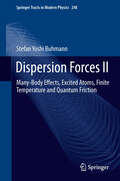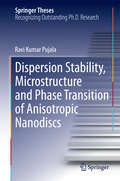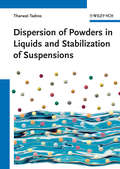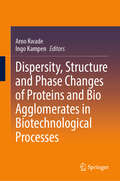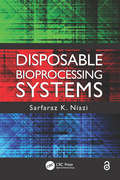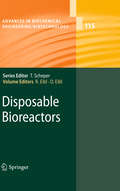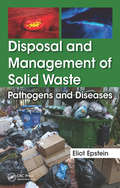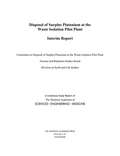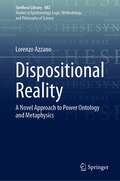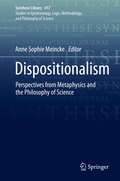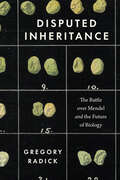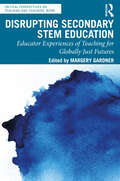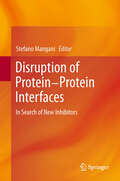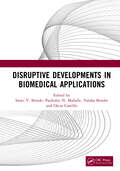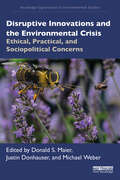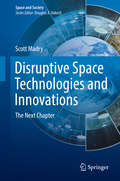- Table View
- List View
Dispersion Forces II
by Stefan BuhmannIn this book, a modern unified theory of dispersion forces on atoms and bodies is presented which covers a broad range of different aspects and scenarios. Macroscopic quantum electrodynamics is applied within the context of dispersion forces. In contrast to the normal-mode quantum electrodynamics traditionally used to study dispersion forces, the new approach allows to consider realistic material properties including absorption and is flexible enough to be applied to a broad range of geometries. Thus general properties of dispersion forces like their non-additivity and the relation between microscopic and macroscopic dispersion forces are discussed. It is demonstrated how the general results can be used to obtain dispersion forces on atoms in the presence of bodies of various shapes and materials. In particular, nontrivial magnetic properties of the bodies, bodies of irregular shapes, the role of material absorption, and dynamical forces for excited atoms are discussed. This volume 2 deals especially with quantum electrodynamics, dispersion forces, Casimir forces, asymptotic power laws, quantum friction and universal scaling laws. The book gives both the specialist and those new to the field a thorough overview over recent results in the context of dispersion forces. It provides a toolbox for studying dispersion forces in various contexts.
Dispersion Relations in Heavily-Doped Nanostructures
by Kamakhya Prasad GhatakThis book presents the dispersion relation in heavily doped nano-structures. The materials considered are III-V, II-VI, IV-VI, GaP, Ge, Platinum Antimonide, stressed, GaSb, Te, II-V, HgTe/CdTe superlattices and Bismuth Telluride semiconductors. The dispersion relation is discussed under magnetic quantization and on the basis of carrier energy spectra. The influences of magnetic field, magneto inversion, and magneto nipi structures on nano-structures is analyzed. The band structure of optoelectronic materials changes with photo-excitation in a fundamental way according to newly formulated electron dispersion laws. They control the quantum effect in optoelectronic devices in the presence of light. The measurement of band gaps in optoelectronic materials in the presence of external photo-excitation is displayed. The influences of magnetic quantization, crossed electric and quantizing fields, intense electric fields on the on the dispersion relation in heavily doped semiconductors and super-lattices are also discussed. This book contains 200 open research problems which form the integral part of the text and are useful for graduate students and researchers. The book is written for post graduate students, researchers and engineers.
Dispersion Stability, Microstructure and Phase Transition of Anisotropic Nanodiscs
by Ravi Kumar PujalaThis thesis explores the dispersion stability, microstructure and phase transitions involved in the nanoclay system. It describes the recently discovered formation of colloidal gels via two routes: the first is through phase separation and second is by equilibrium gelation and includes the first reported experimental observation of a system with high aspect ratio nanodiscs. The phase behavior of anisotropic nanodiscs of different aspect ratio in their individual and mixed states in aqueous and hydrophobic media is investigated. Distinct phase separation, equilibrium fluid and equilibrium gel phases are observed in nanoclay dispersions with extensive aging. The work then explores solution behavior, gelation kinetics, aging dynamics and temperature-induced ordering in the individual and mixed states of these discotic colloids. Anisotropic ordering dynamics induced by a water-air interface, waiting time and temperature in these dispersions were studied in great detail along with aggregation behavior of nanoplatelets in hydrophobic environment of alcohol solutions.
Dispersion of Powders in Liquids and Stabilization of Suspensions
by Tharwat F. TadrosTeaching the fundamental knowledge required for successful dispersion of powders in a liquid, this book covers a host of topics -- from recent advances to industrial applications.In 15 chapters it supports formulation chemists in preparing a suspension in a more rational way, by applying the principles of colloid and interface science, while at the same time enabling the research scientist to discover new methods for preparing stable suspensions.Essential reading for those working in the pharmaceutical, cosmetic, food, paint, ceramic and agricultural industries.
Dispersions: Characterization, Testing, and Measurement (Surfactant Science Ser. #84)
by Erik KissaExplaining principles essential for the interpretation of data and understanding the real meaning of the result, this work describes carious methods and techniques used to characterize dispersions and measure their physical and chemical properties. It describes a variety of dispersions containing particles ranging from submicron sizes to aggregates and from hard particles to polymer latices.
Dispersity, Structure and Phase Changes of Proteins and Bio Agglomerates in Biotechnological Processes
by Arno Kwade Ingo KampenThis book serves as a comprehensive summary of the priority program SPP 1934, which focused on understanding the dispersity, structure, and phase changes of proteins and bio-agglomerates in biotechnological processes. Through contributions from various research groups, the program explored how sensitive proteins and bio-agglomerates are affected by the process environment during fermentation, downstream processing, and formulation. It investigated these effects across three size scales: microscale, encompassing single proteins, clusters, crystals, and virus-like particles; mesoscale, focusing on cells and cell clusters; and macroscale, examining overall process dynamics. The main objective was to enhance biotechnological process chains by elucidating the mechanical, thermal, and chemical stresses that impact protein and bio-agglomerate structures. By gaining insights into these stressors, the program aimed to enable precise control measures to mitigate denaturation and unfavorable growth of proteins and cells. This compilation seeks to contribute to the optimization of biotechnological processes, facilitating advancements in various industries.
Disposable Bioprocessing Systems
by Sarfaraz K. NiaziWritten by a researcher with experience designing, establishing, and validating biological manufacturing facilities worldwide, this is the first comprehensive introduction to disposable systems for biological drug manufacturing. It reviews the current state of the industry; tackles questions about safety, costs, regulations, and waste disposal; and guides readers to choose disposable components that meet their needs. This practical manual covers disposable containers, mixing systems, bioreactors, connectors and transfers, controls and sensors, downstream processing systems, filling and finishing systems, and filters. The author also shares his predictions for the future, calling disposable bioprocessing technology a "game changer."
Disposable Bioreactors II
by Regine Eibl Dieter EiblDynamic Single-Use Bioreactors Used in Modern Liter- and m3- Scale Biotechnological Processes: Engineering Characteristics and Scaling Up, by Christian Löffelholz, Stephan C. Kaiser, Matthias Kraume, Regine Eibl , Dieter Eibl. Orbitally Shaken Single-Use Bioreactors, by Wolf Klöckner, Sylvia Diederichs, Jochen Büchs. Therapeutic Human Cells: Manufacture for Cell Therapy/Regenerative Medicine by Christian van den Bos, Robert Keefe, Carmen Schirmaier, Michael McCaman. Fast Single-Use VLP Vaccine Productions Based on Insect Cells and the Baculovirus Expression Vector System: Influenza as Case Study by Regine Eibl, Nina Steiger, Sabine Wellnitz, Tiago Vicente, Corinne John, Dieter Eibl. Microbial High Cell Density Fermentations in a Stirred Single-Use Bioreactor by Thomas Dreher, Bart Walcarius, Ute Husemann, Franziska Klingenberg, Christian Zahnow, Thorsten Adams, Davy de Wilde, Peter Casteels, Gerhard Greller. Quorus Bioreactor: A New Perfusion-Based Technology for Microbial Cultivation by Sheena J. Fraser, Christian Endres. Cultivation of Marine Microorganisms in Single-Use Systems by Friederike Hillig, Maciej Pilarek, Stefan Junne, Peter Neubauer. Flexible Biomanufacturing Processes that Address the Needs of the Future by Bernhard Diel, Christian Manzke, Thorsten Peuker. An Approach to Quality and Security of Supply for Single-Use Bioreactors by Magali Barbaroux, Susanne Gerighausen, Heiko Hackel. A Risk Analysis for Production Processes with Disposable Bioreactors by Tobias Merseburger, Ina Pahl, Daniel Müller, Markus Tanner.
Disposable City: Miami's Future on the Shores of Climate Catastrophe
by Mario Alejandro ArizaA deeply-reported personal investigation by a Miami journalist into the present and future effects of climate change in the Magic City-a watery harbinger for coastal cities worldwide.Miami, Florida, is likely to be entirely underwater by the end of this century. Residents are already starting to see the effects of sea level rise today. From sunny day flooding caused by higher tides to a sewer system on the brink of total collapse, the city undeniably lives in a climate changed world. In Disposable City, Miami resident Mario Alejandro Ariza shows us not only what climate change looks like on the ground today, but also what Miami will look like 100 years from now, and how that future has been shaped by the city's racist past and present. As politicians continue to kick the can down the road and Miami becomes increasingly unlivable, real estate vultures and wealthy residents will be able to get out or move to higher ground, but the most vulnerable communities, disproportionately composed of people of color, will face flood damage, rising housing costs, dangerously higher temperatures, and stronger hurricanes that they can't afford to escape. Miami may be on the front lines of climate change, but the battle it's fighting today is coming for the rest of the U.S.--and the rest of the world--far sooner than we could have imagined even a decade ago. Disposable City is a thoughtful portrait of both a vibrant city with a unique culture and the social, economic, and psychic costs of climate change that call us to act before it's too late.
Disposal and Management of Solid Waste: Pathogens and Diseases
by Eliot EpsteinDisposal and Management of Solid Waste: Pathogens and Diseases takes a closer look at pathogens that are found in solid wastes and the diseases that they produce. While comparing the differences between developed and developing countries, this book provides an understanding of the risks and exposure of pathogens in solid wastes, addresses pathogens
Disposal of Dangerous Chemicals in Urban Areas and Mega Cities
by Ian Barnes Krzysztof J. RudzińskiOxides and acids of nitrogen play an important role in regulating atmospheric radical levels, in particular, that of the OH radical the main initiator of the degradation of chemicals in the atmosphere. A comprehensive overview on the methods used to measure nitrogen oxides and acids in the troposphere is given and difficulties and artefacts associated with the use of the techniques for measurements in urban and mega city environments is illustrated. State-of-the-art methods for the measurement of OH and HO2 radicals are reviewed and recently recognised difficulties, in particular with the measurement of HO2 radicals, are highlighted. Other contributions to the book cover our present understanding of the gas, aqueous and particulate/aerosol phase atmospheric degradation chemistry of volatile organic compounds (VOCs) under NOx conditions typical of rural, urban and mega city environments. Examples of measurements of NOx and VOCs in the atmospheres of these environments are given, in particular for the megacities Cairo and Beijing, in conjunction with modelling studies which attempt to simulate the field observations using state-of-the art knowledge on the chemistry of the VOCs and radical levels.
Disposal of Surplus Plutonium at the Waste Isolation Pilot Plant: Interim Report
by Engineering Medicine National Academies of SciencesDisposal of Surplus Plutonium at the Waste Isolation Pilot Plant: Interim Report evaluates the general viability of the U.S. Department of Energy’s National Nuclear Security Administration’s (DOE-NNSA’s) conceptual plans for disposing of 34 metric tons (MT) of surplus plutonium in the Waste Isolation Pilot Plant (WIPP), a deep geologic repository near Carlsbad, New Mexico. This report evaluates DOE-NNSA’s plans to ship, receive, and emplace surplus plutonium in WIPP and its understanding of the impacts of these plans on WIPP and WIPP-bound waste streams. This report, the first of two to be issued during this study, provides a preliminary assessment of the general viability of DOE-NNSA’s conceptual plans, focusing on some of the barriers to their implementation.
Dispositional Reality: A Novel Approach to Power Ontology and Metaphysics (Synthese Library #482)
by Lorenzo AzzanoDispositionalism, perhaps the most popular variant of non-Humean metaphysics, submits that dispositions, powers, or capacities, are part of the furniture of the world. In this book I advance an original approach to dispositionalism revolving around the notion of Dispositional Reality; the novelty lies in the fact that the account, unlike most alternatives on the market, does not require the reification of objects, facts, properties, nor their dispositional essences – and is in fact compatible with a far more deflationary approach to dispositions, while still being true to the non-Humean spirit of the proposal. This power metaphysics without powers allows one to dispel several puzzles in recent literature, or recast them under a new light. Albeit with its own peculiarities, this proposal constitutes a variant of explanatory dispositionalism, according to which realism about dispositions ought not to be understood as an ontological inflation, but as an explanatory inversion within thenomic and modal family. Some of these explanations are hereby attempted, and a study of various types of non-causal explanation will be provided.
Dispositionalism: Perspectives from Metaphysics and the Philosophy of Science (Synthese Library #417)
by Anne Sophie MeinckeAccording to dispositional realism, or dispositionalism, the entities inhabiting our world possess irreducibly dispositional properties – often called ‘powers’ – by means of which they are sources of change. Dispositionalism has become increasingly popular among metaphysicians in the last three decades as it offers a realist account of causation and provides novel avenues for understanding modality, laws of nature, agency, free will and other key concepts in metaphysics. At the same time, it is receiving growing interest among philosophers of science. This reflects the substantial role scientific findings play in arguments for dispositionalism which, as a metaphysics of science, aims to unveil the very foundations of science. The present collection of essays brings together both strands of interest. It elucidates the ontological profile of dispositionalism by exploring its ontological commitments, and it discusses these from the perspective of the philosophy of science. The essays are written by both proponents of dispositionalism and sceptics so as to initiate an open-minded, constructive dialogue.
Disputed Inheritance: The Battle over Mendel and the Future of Biology
by Gregory RadickA root-and-branch rethinking of how history has shaped the science of genetics. In 1900, almost no one had heard of Gregor Mendel. Ten years later, he was famous as the father of a new science of heredity—genetics. Even today, Mendelian ideas serve as a standard point of entry for learning about genes. The message students receive is plain: the twenty-first century owes an enlightened understanding of how biological inheritance really works to the persistence of an intellectual inheritance that traces back to Mendel’s garden. Disputed Inheritance turns that message on its head. As Gregory Radick shows, Mendelian ideas became foundational not because they match reality—little in nature behaves like Mendel’s peas—but because, in England in the early years of the twentieth century, a ferocious debate ended as it did. On one side was the Cambridge biologist William Bateson, who, in Mendel’s name, wanted biology and society reorganized around the recognition that heredity is destiny. On the other side was the Oxford biologist W. F. R. Weldon, who, admiring Mendel's discoveries in a limited way, thought Bateson's "Mendelism" represented a backward step, since it pushed growing knowledge of the modifying role of environments, internal and external, to the margins. Weldon's untimely death in 1906, before he could finish a book setting out his alternative vision, is, Radick suggests, what sealed the Mendelian victory. Bringing together extensive archival research with searching analyses of the nature of science and history, Disputed Inheritance challenges the way we think about genetics and its possibilities, past, present, and future.
Disputed Inheritance: The Battle over Mendel and the Future of Biology
by Gregory RadickA root-and-branch rethinking of how history has shaped the science of genetics. In 1900, almost no one had heard of Gregor Mendel. Ten years later, he was famous as the father of a new science of heredity—genetics. Even today, Mendelian ideas serve as a standard point of entry for learning about genes. The message students receive is plain: the twenty-first century owes an enlightened understanding of how biological inheritance really works to the persistence of an intellectual inheritance that traces back to Mendel’s garden. Disputed Inheritance turns that message on its head. As Gregory Radick shows, Mendelian ideas became foundational not because they match reality—little in nature behaves like Mendel’s peas—but because, in England in the early years of the twentieth century, a ferocious debate ended as it did. On one side was the Cambridge biologist William Bateson, who, in Mendel’s name, wanted biology and society reorganized around the recognition that heredity is destiny. On the other side was the Oxford biologist W. F. R. Weldon, who, admiring Mendel's discoveries in a limited way, thought Bateson's "Mendelism" represented a backward step, since it pushed growing knowledge of the modifying role of environments, internal and external, to the margins. Weldon's untimely death in 1906, before he could finish a book setting out his alternative vision, is, Radick suggests, what sealed the Mendelian victory. Bringing together extensive archival research with searching analyses of the nature of science and history, Disputed Inheritance challenges the way we think about genetics and its possibilities, past, present, and future.
Disrupting Copyright: How Disruptive Innovations and Social Norms are Challenging IP Law (Intellectual Property, Theory, Culture)
by Margery R HilkoNew innovations are created every day, but today’s business leaders are focused on finding disruptive innovations which are cheaper and lower performing than upmarket technologies. They create new markets, and challenge the status quo of existing technological thinking creating uncertainty both in the future of the innovation and the outcome of the market upheaval. Disruptive innovation is an influential innovation theory in business, but how does it affect the law? Several of these technologies have brought new ways for individuals to deal with copyright works while disrupting existing market expectations, while their ability to spawn social norms has presented challenges for legislation. Considering disruptive innovation as a class, this book examines innovations that have impacted copyright in the past, what lessons can be learned from how the law interacted with them, and how the law can successfully deal with them going forward. Creating comprehensive guidance that can be used when faced with disruptive innovations with the aim of more successful legislation, it considers whether copyright law itself has been disrupted through these innovations. Exploring whether disruptive innovations as a class have unique properties that necessitate action by legislators and whether these properties have the possibility to disrupt the law itself, this book theorises how the law should deal with disruptive innovations in general, going beyond a discussion of the regulation of specific innovations to develop a framework for how law makers should deal with disruptive innovations when faced by one.
Disrupting Science: Social Movements, American Scientists, and the Politics of the Military, 1945-1975 (Princeton Studies in Cultural Sociology)
by Kelly MooreIn the decades following World War II, American scientists were celebrated for their contributions to social and technological progress. They were also widely criticized for their increasingly close ties to military and governmental power--not only by outside activists but from among the ranks of scientists themselves. Disrupting Science tells the story of how scientists formed new protest organizations that democratized science and made its pursuit more transparent. The book explores how scientists weakened their own authority even as they invented new forms of political action. Drawing extensively from archival sources and in-depth interviews, Kelly Moore examines the features of American science that made it an attractive target for protesters in the early cold war and Vietnam eras, including scientists' work in military research and activities perceived as environmentally harmful. She describes the intellectual traditions that protesters drew from--liberalism, moral individualism, and the New Left--and traces the rise and influence of scientist-led protest organizations such as Science for the People and the Union of Concerned Scientists. Moore shows how scientist protest activities disrupted basic assumptions about science and the ways scientific knowledge should be produced, and recast scientists' relationships to political and military institutions. Disrupting Science reveals how the scientific community cumulatively worked to unbind its own scientific authority and change how science and scientists are perceived. In doing so, the book redefines our understanding of social movements and the power of insider-led protest.
Disrupting Secondary STEM Education: Educator Experiences of Teaching for Globally Just Futures (Critical Perspectives on Teaching and Teachers’ Work)
by Margery GardnerThis volume brings into focus the pivotal educational years during adolescence, when many learners are exposed to implicit and explicit messages that STEM is not a viable educational pathway for them.Challenging this notion, Disrupting Secondary STEM Education brings together a collective of critical educators who share what disruptive STEM teaching looks and feels like from an insider perspective, as well as the ways they purposefully create curriculum to subvert existing structures that can confine learning. Through disruptive STEM teaching, a joy for learning is kindled, as well as a sense of empowered criticality in students that can support their development as global citizens facing complex futures. The collection shares stories across a spectrum of educators, from those beginning their teaching journey to those who’ve stood up against narrow curriculum and standardized testing for years in the capacity of both P-12 teachers and teacher educators. The voices of these educators illustrate how the work of disruptive STEM teaching can be actualized within cohorts of future teachers, achieved through early engagement with critical theories and generative field experiences that support and affirm a wide array of identities.This book provides multiple theoretical and practical access points for the reader to understand the work of disruptive STEM teaching and offers a way forward for those interested in developing more critical curriculum in their own classrooms. As such, it will be important reading for postgraduate students and researchers in Social Justice Education and STEM Education, as well as for in-service educators.
Disruption in the Infrastructure Sector: Challenges and Opportunities for Developers, Investors and Asset Managers (Future of Business and Finance)
by Stefano Gatti Carlo ChiarellaA number of dramatic changes are currently reshaping infrastructure, a sector that investors and asset managers have traditionally considered to be a safe harbor in the field of alternative investments. Understanding the future of infrastructure is indispensable to guaranteeing a sustainable future for our planet and the welfare of the world’s population, and enhancing our knowledge of this asset class is one important step we can take toward reaching this crucial goal. This book collects a series of contributions by a group of Bocconi University researchers under the Antin IP Associate Professorship in Infrastructure Finance, which cover the key megatrends that are expected to reshape the way we think about infrastructure, and the implications for infrastructure investors and asset managers. Its goal is to improve and disseminate the culture of infrastructure among academics, professionals and policymakers. The main focus is on Europe and the European Union, and specifically on three key sectors: power and energy, transportation infrastructure, and telecoms / ICT.
Disruption of Protein-Protein Interfaces: In Search of New Inhibitors
by Stefano Mangani"Disruption of Protein-Protein Interfaces" reviews the latest developments and future perspectives in drug discovery at protein-protein interfaces. The authors detail experimental and computational tools to tackle the subject and highlight the contribution of the Italian research community to the field. Evidence shows that blocking or modulating protein-protein interactions might lead to the development of useful new drugs. Consequently, in recent years great effort has been dedicated to unveiling the molecular details of protein-protein interfaces by structural techniques e.g. X-ray diffraction, NMR spectroscopy. This book, written and edited by leaders in the field, provides examples from the literature of successes and failures to develop drug-like molecules effective in interacting at protein-protein interfaces.
Disruptive Developments in Biomedical Applications
by Oscar Castillo Parikshit N. Mahalle Swati V. Shinde Varsha BendreThis book covers advancements and future challenges in biomedical application development using disruptive technologies like AI, IoT and signal processing. Book is divided into four main sections namely medical image processing using AI, IoT and biomedical devices, biomedical signal processing and electronic health records including advances in biomedical systems. It includes different case studies of biomedical applications using different AI algorithms related to diabetes, skin cancer, breast cancer, cervical cancer, osteoarthritis, and so forth. Features: Covers different technologies like AI, IOT and signal processing in the context of biomedical applications. Reviews medical image analysis, disease detection, and prediction. Comprehends the advantage of recent technologies for medical record keeping through electronics health records (EHRs). Presents state of art research in the field of biomedical engineering using various physiological signals. Explores different Bio Sensors used in Healthcare Applications using IOT. This book aims at Graduate students and researchers in artificial intelligence, medical imaging, biomedical engineering, and internet of things.
Disruptive Innovations and the Environmental Crisis: Ethical, Practical, and Sociopolitical Concerns (Routledge Explorations in Environmental Studies)
by Michael Weber Donald S. Maier Justin DonhauserThis book probes the ethical, practical, and sociopolitical implications of leveraging innovative and disruptive means to address the world’s various environmental crises.Packed with keen observations and analyses, the volume brings together research from seasoned scholars and rising stars to cast important new light on urgent issues engendered by humankind’s disruption of environments, such as climate change and biodiversity loss. It tackles the question of exactly what has been disrupted in the world—environmentally, economically, socially, and politically. It also examines an assortment of innovative interventions that aim to address disruptions and explores the question of what further disruptions may lurk behind assorted innovative interventions intended to address already existing disruptions. Chapters wrestle with the social, ethical, and ecological implications of disruptions, both pre-existing and those brought about by interventions, connected with deploying artificial gene drives, substituting robotic pollinators for living ones, synthesizing organisms to replace ones lost, installing economic regimes that work well for both citizens and the environment, making science subservient to non-scientific commitments, involving citizens in environmentally consequential decisions, choosing scientific and technological projects that most promise immediate practical payoff, and ensuring that respect for human rights is part and parcel of any technology-infused project. These discussions draw on a rich mix of science, philosophy of science, political theory, economics, sociology, network theory, ethics, and theories of justice and human rights.This book will be of great interest to students and scholars of environmental science, environmental decision-making, ecology, climate change, environmental philosophy, and the philosophy of science.
Disruptive Space Technologies and Innovations: The Next Chapter (Space and Society)
by Scott MadryIn the past century alone, we have witnessed groundbreaking technological innovations quickly displace established industries, thereby opening up entirely new markets or fields of research. Such "disruptive technologies" are hard to predict in advance, and yet, they have the potential to significantly alter the course of history. Written by one of the world’s leading space applications experts, this book addresses the concept of disruptive technologies in the space arena, including microsatellites, the development of satellite constellations, and reusable launch vehicles.The book presents several case studies in the field, and discusses how and why modern space technologies are so unique. It covers current examples of disruptive space businesses, the pros and cons of such disruption, key emerging trends, and possible developments on the horizon.
